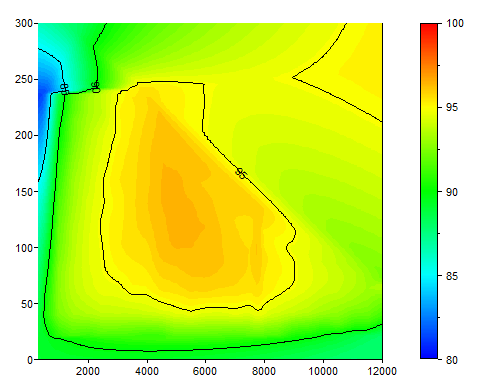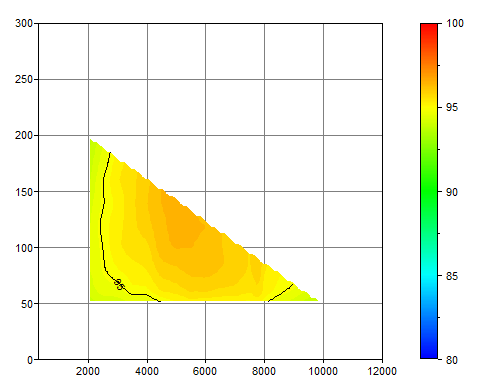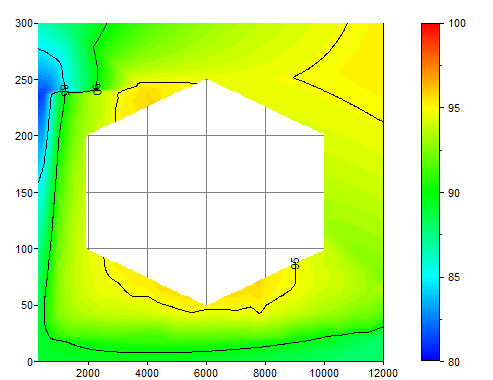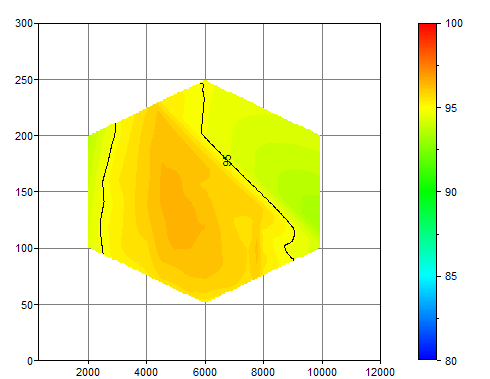Clip2D (FPScript)
Cuts surfaces at an edge or along a closed curve.
Syntax
Clip2D(Surface, CuttingEdge, Mode)
The syntax of the Clip2D function consists of the following parts:
Part |
Description |
||||||||||||||
|---|---|---|---|---|---|---|---|---|---|---|---|---|---|---|---|
Surface |
The surface to be cut, which may be a data matrix/signal series or space curve. If you specify a data series or a data matrix, then the X and Z components will be generated automatically. Permitted data structures are data matrix, signal series und space curve. All numeric data types are permitted. If the argument is a list, then the function is executed for each element of the list and the result is also a list. |
||||||||||||||
CuttingEdge |
Specifies the cutting edge to cut along. Permitted data structures are scalar value und signal. All numeric data types are permitted. If the argument is a list, then the first element in the list is taken. If this is also a list, then the process is repeated. |
||||||||||||||
Mode |
Specifies the mode of how the data set is to be cut. The argument Mode can have the following values:
If the argument is a list, then the first element in the list is taken. If this is also a list, then the process is repeated. |
Remarks
If Surface is of the calendar time or time span data type, then this also applies for the result. For all other Surface data types, the data type of the result is a 64-bit floating point value.
If the argument CuttingEdge is specified as a scalar value, all Y values are set to void, whose X values are greater than ( CLIP2D_XMAX), less than (CLIP2D_XMIN), or whose Z values are greater than (CLIP2D_ZMAX) or less than (CLIP2D_ZMIN) the specified limit.
If the argument CuttingEdge is specified as a signal, the Y component corresponds to the dimension of the surface to be cut and the X component corresponds to the other dimension. Interpolation will be used, if necessary. For Mode equal to CLIP2D_XMAX or CLIP2D_XMIN , the Y component of the signal corresponds to the X component of the surface, for instance, and the X component of the signal corresponds to the Y component of the surface.
For the modes CLIP2D_CURVEOUTSIDE and CLIP2D_CURVEINSIDE , the argument CuttingEdge must be specified as a signal. The Y and X values of the signal must then form a closed curve along which to cut. The Y values of the signal are thus assigned to the Z component of the surface, and the X values are assigned to their X component. The curve specified by the signal is closed automatically, which means that the first point in the signal does not have to match the last point.
Constant |
Method |
|---|---|
CLIP2D_XMAX |
All Y values whose assigned X value is above the specified cutting edge are set to void. |
CLIP2D_XMIN |
All Y values whose assigned X value is below the specified cutting edge are set to void. |
CLIP2D_ZMAX |
All Y values whose assigned Z value is above the specified cutting edge are set to void. |
CLIP2D_ZMIN |
All Y values whose assigned Z value is below the specified cutting edge are set to void. |
CLIP2D_CURVEOUTSIDE |
All Y values whose assigned X, Z coordinates are outside the closed curve passed as the argument CuttingEdge are set to void. |
CLIP2D_CURVEINSIDE |
All Y values whose assigned X, Z coordinates are within the closed curve passed as the argument CuttingEdge are set to void. |
For complex data types the absolute value is formed.
Available in
FlexPro Basic, Professional, Developer Suite
Examples
Dim d = Data
d = Clip2D(d, 2000, CLIP2D_XMIN)
d = Clip2D(d, 10000, CLIP2D_XMAX)
d = Clip2D(d, 50, CLIP2D_ZMIN)
d = Clip2D(d, Signal({200,50},{2000,10000}), CLIP2D_ZMAX)
In the following example, a surface is cut in the X direction as well as in the Z direction.


Clip2D(Data, Signal({100,200,250,200,100,50},{2000,2000,6000,10000,10000,6000}), CLIP2D_CURVEINSIDE)
Clip2D(Data, Signal({100,200,250,200,100,50},{2000,2000,6000,10000,10000,6000}), CLIP2D_CURVEOUTSIDE)
The following example shows how a contour with a closed curve is cut.


See Also
You might be interested in these articles
You are currently viewing a placeholder content from Facebook. To access the actual content, click the button below. Please note that doing so will share data with third-party providers.
More InformationYou need to load content from reCAPTCHA to submit the form. Please note that doing so will share data with third-party providers.
More InformationYou are currently viewing a placeholder content from Instagram. To access the actual content, click the button below. Please note that doing so will share data with third-party providers.
More InformationYou are currently viewing a placeholder content from X. To access the actual content, click the button below. Please note that doing so will share data with third-party providers.
More Information